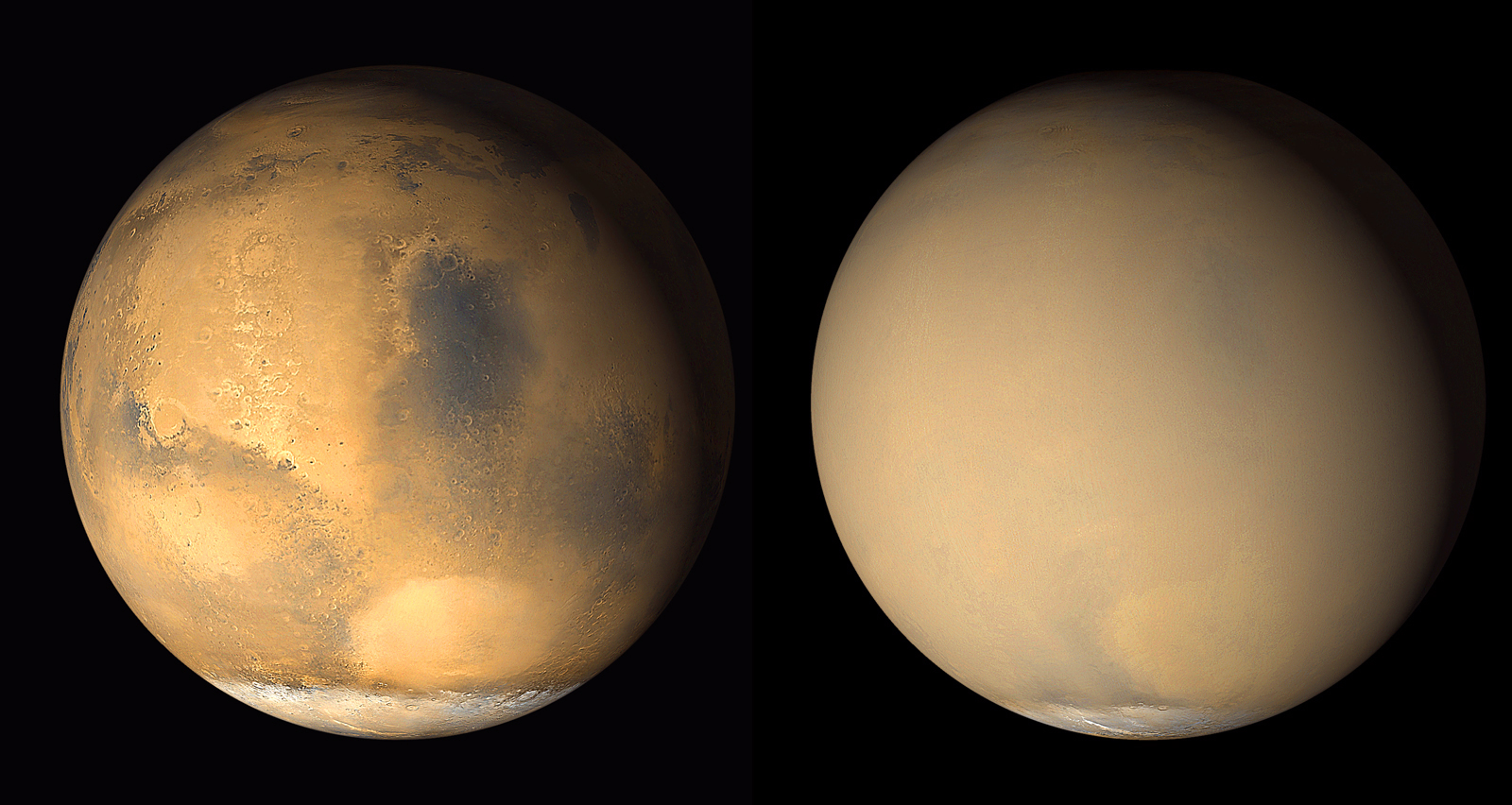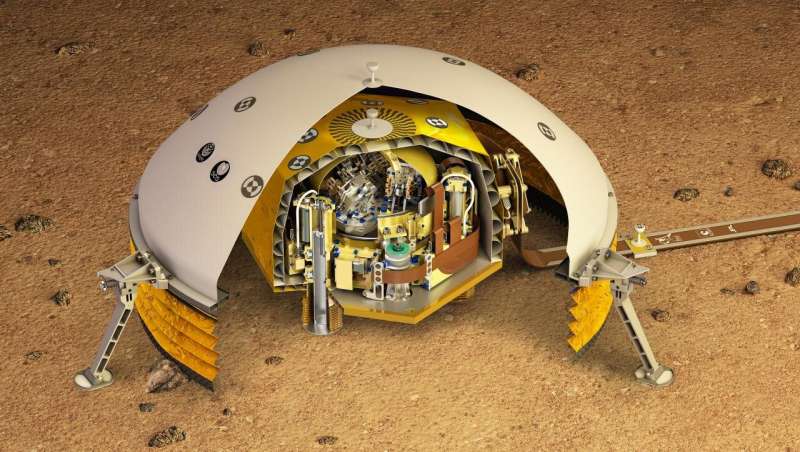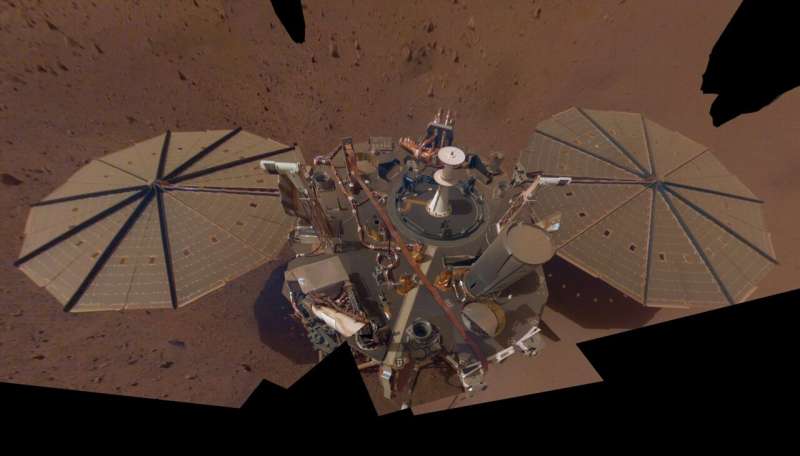By favoring the release of hydrogen from the atmosphere of Mars, regional dust storms contribute in an important way to the loss of water by the Red Planet: these are the results of the analysis of a Martian dust storm observed in 2019 by the Mars Reconnaissance Orbiter probes. , Trace Gas Orbiter and Maven. Giancarlo Bellucci from INAF also participated in the study
Mars , now an arid and dry planet, has not always been this way: three and a half billion years ago it was quite similar to Earth, with vast oceans of liquid water covering its surface and an atmosphere denser and more humid than it is today. . Some of this water is currently found in the ice caps at the poles or in the planet’s crust, but a significant portion has been lost over billions of years.
In the 1970s, the Mariner 6 and 7 probes provided the first data to study these ” gas leaks “, which scientists had initially interpreted as a slow and constant phenomenon. However, more recent observations have shown a strong seasonal variability: during the summer, the atmosphere is warmer and water vapor tends to rise more. Above, the atmosphere is more tenuous and the molecules are more vulnerable to ultraviolet radiation from the Sun, which separates the hydrogen atoms from the oxygen ones and favors their escape.
On Mars, however, not all summers are the same: there are peaks of hydrogen loss in the southern hemisphere summer – which occurs near perihelion, the closest point to the Sun along the planet’s orbit – higher than ten to one hundred times the values measured in the northern hemisphere summer. In addition to seasonal variations, the role of dust storms in favoring this process has also been investigated for some time , in particular the global ones that envelop the planet every 1–3 Martian years: the dust heats the atmosphere, triggering similar hydrogen leaks.
A new study, published today in the journal Nature Astronomy , reveals the importance in this balance of a factor largely underestimated until now: the dust storms on a regional scale . Smaller but more frequent than their global counterparts, these short-lived storms would nowadays play a key role in fostering the loss of hydrogen and with it the relentless drying out of the Red Planet. According to the new findings, Mars loses twice the amount of water during a regional dust storm compared to an entire summer season in the southern hemisphere in the absence of regional storms.

So far, it was the lack of data that had not allowed researchers to study regional dust storms in detail. That all changed in early 2019, when a more unique than rare coincidence sees the orbits of three space probes around Mars – NASA’s Mars Reconnaissance Orbiter (Mro) and Maven , and ExoMars’ Trace Gas Orbiter (Tgo), a collaboration between ESA and Roscosmos – to line up precisely on the occasion of one of these “fuss”. It was thus possible to observe the region affected by the storm, which unleashed in early January and lasted for several weeks, with four instruments: Mars Climate Sounder on Mro, Imaging Ultraviolet Spectrograph on Maven, and on board the Tgo both Nomad (Nadir and Occultation for Mars Discovery), a Belgian-Spanish-Italian-British-led instrument, whose Italian contribution is financed by the Italian Space Agency, which the Russian-led instrument Acs (Atmospheric Chemistry Suite).
“We really captured the whole system in action,” comments lead author Michael S. Chaffin of the University of Colorado at Boulder.
By combining the data from the four instruments, the researchers were able to measure the temperature and concentration of dust and water ice from the surface up to about one hundred kilometers of altitude with Mro, the concentration of water vapor and ice in the same altitude range with Tgo. , and the quantity of hydrogen – deriving from water vapor molecules “broken” by solar radiation – up to a thousand kilometers of altitude with Maven. In particular, the Nomad instrument aboard Tgo measures with extreme precision the abundance of gases present at various altitudes in the atmosphere of Mars through the solar occultation technique., observing sunlight passing through the atmosphere to measure very small amounts of gas molecules, including water vapor, present at different altitudes.
“In the study published today, Nomad data were used to measure the abundance of water vapor before and during a regional dust storm,” explains Giancarlo Bellucci , INAF researcher in Rome, co-principal investigator of the Nomad instrument and co-principal author of the research.
Together with Acs, Nomad showed the presence of water vapor in the lower atmosphere before the start of the dust storm; then, as it rose, heating the atmosphere and triggering the winds, the instruments revealed the water vapor catapulted to higher altitudes. “It has been seen that the water, due to the dust storm, is pumped from the troposphere up to altitudes of 60 km. At these heights, water molecules are broken up by solar radiation and dispersed into space. Since regional storms are more frequent than global ones, this mechanism can explain how Mars has lost much of its water over time », adds Bellucci.

After the storm began, the instruments aboard TGO measured ten times more water in the central part of the central atmosphere. These observations coincide with what MRO detected: the radiometer on board the probe has in fact measured the increase in temperatures in the atmosphere as the dust accumulated above Mars.
“The instruments should all tell the same story, and they do,” points out co-author Geronimo Villanueva of the NASA Goddard Space Flight Center in Greenbelt, Maryland.
MRO also saw the clouds of water ice disappear, as expected as the ice could no longer condense near the surface, which had warmed in the meantime. Further confirmation came from the ultraviolet spectrograph images aboard Maven: the ice clouds, visible before the storm over the volcanoes in the Martian region of Tharsis and completely disappeared during the storm, reappeared soon after. Maven’s observations also captured an aurora in the upper atmosphere accompanied by a fifty percent increase in hydrogen during the storm, reflecting the breakdown of water vapor into hydrogen and oxygen by solar radiation; the increase in hydrogen corresponded to the water measured, a week earlier, at 60 km of altitude,
“This article helps us to virtually go back in time and say,” Okay, now we have another way to lose water that will help us relate the little water we have today on Mars to the huge amount of water we had in the world. past ”», concludes Villanueva.
Featured image: Diagram of the water cycle in the atmosphere of Mars (click to enlarge). Credits: Esa
To know more:
- Read on Nature Astronomy the article ” Martian Water Loss to Space Enhanced by Regional Dust Storms ” by MS Chaffin, DM Kass, S. Aoki, AA Fedorova, J. Deighan, K. Connour, NG Heavens, A. Kleinböhl, SK Jain , J.-Y. Chaufray, M. Mayyasi, JT Clarke, AIF Stewart, JS Evans, MH Stevens, W E. McClintock, M. Crismani, GM Holsclaw, F. Lefevre, DY Lo, F. Montmessin6, NM Schneider, B. Jakosky, G. Villanueva, G. Liuzzi, F. Daerden, IR Thomas, J.-J. Lopez-Moreno, MR Patel, G. Bellucci, B. Ristic, JT Erwin, AC Vandaele, A. Trokhimovskiy, OI Korablev
Provided by INAF














